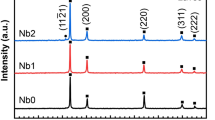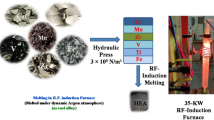Abstract
The electrochemical behaviour of aluminium alloyed with small amounts (up to 0.2%) of indium, gallium and thallium has been investigated. It has been found that these additions result in:
-
(a)
A considerable shift of the rest potential in the negative direction (to 1.4–1.7 V versus SCE),
-
(b)
A significant increase of the passivating current density (up to 0.1–1 Acm−2) and
-
(c)
A considerable decrease in the negative difference effect (increase of the faradaic efficiency to
99.5%) compared to the behaviour of pure aluminium. Except for the gallium alloy, the rate of corrosion of the alloys in neutral salt solutions is also decreased compared to that of pure aluminium. A ternary alloy, Al-0.01 In-0.01 Ga, exhibited a more negative rest potential than the Al-In alloy and a corrosion stability superior to that of the Al-Ga alloy. The negative difference effect was found to depend on the cation of the neutral salt in solution. The lowest effect was obtained in ammonium chloride solutions.
Similar content being viewed by others
References
W. M. Latimer, ‘Oxidation Potentials’, Prentice Hall, New York, 1952.
J. M. Kolthoff and J. J. Lingane, ‘Polarography’, Vol. II. Interscience Publishers, New York 1952, p. 513–8.
W. O. Kroenig and V. N. Uspenskaja,Korrosion u. Metallschutz,11, (1935) 10.
E. G. Ivanov, E. A. Berkman and G. M. Petrova,Sbornik Rabot po Khimicheskim, Istochnikan Toka,9,Energiya (1974) 186.
M. M. Purenović, A. R. Despić and D. M. Dražić,Elektrokhimiya,12 (1976) 296.
‘An Electrochemically Active Aluminium Alloy, the Methods of its Preparation and Use’, Institute of Technical Science, The Serbian Academy of Science and Arts, Yug. Pat. Appl. No. P-405 (1975).
A. R. Despić,Bull. T. XLVI Acad. Serbe sci. et arts, classe sci. math. et natur,12 (1969) 79.
A. A. Frost and R. G. Pearson, ‘Kinetics and Mechanism’, John Wiley, New York 1961, p. 209.
M. E. Straumanis,J. Electrochem. Soc. 105 (1958) 284.
Idem, ibid 108 (1961) 1087.
D. V. Kokulana and V. N. Kabanov,DAN SSSR,112 (1957) 692; DAN SSSR,120 (1958) 558;ZFH,34 (1960) 2469.
W. J. Muller,Trans Electrochem. Soc. 76 (1969) 167.
M. E. Straumanis and J. N. Wang,J. Electrochem. Soc. 102 (1955) 304.
N. D. Tomashoff,Light Metals 11 (1948) 505.
M. E. Straumanis,J. Electrochem. Soc. 105 (1958) 284.
G. A. Marsh and E. Schaschl,ibid 107 (1960) 960.
I. T. Reding and J. J. Newport,Materials Protection 5 (1966) 15.
T. Sakano, K. Toda and M. Hanoda,ibid 5 (1966) 45.
Author information
Authors and Affiliations
Rights and permissions
About this article
Cite this article
Despić, A.R., Dražić, D.M., Purenović, M.M. et al. Electrochemical properties of aluminium alloys containing indium, gallium and thallium. J Appl Electrochem 6, 527–542 (1976). https://doi.org/10.1007/BF00614541
Received:
Issue Date:
DOI: https://doi.org/10.1007/BF00614541




